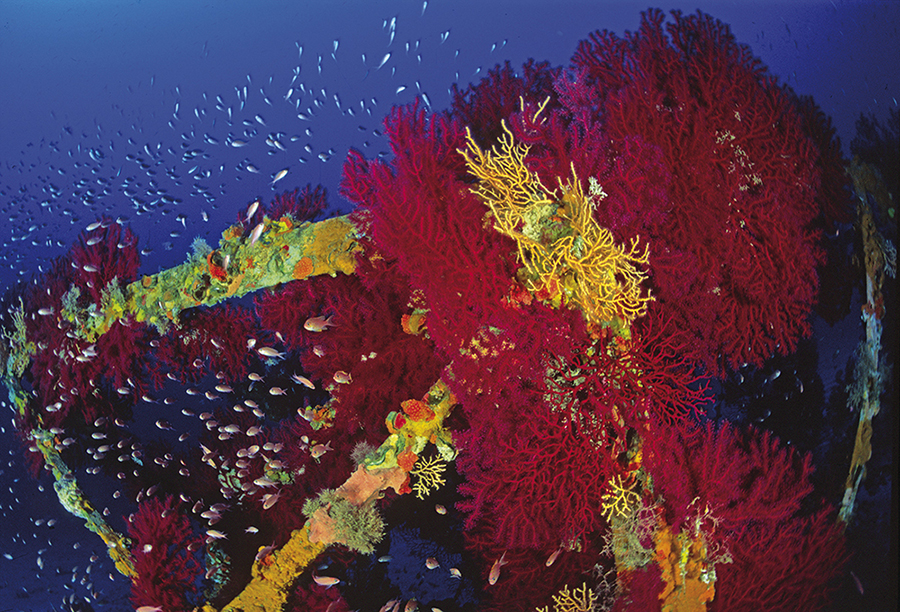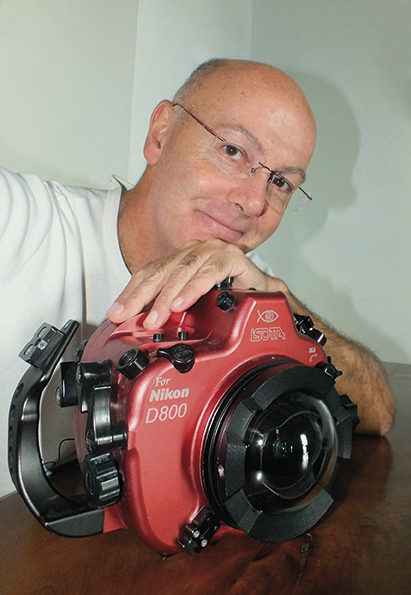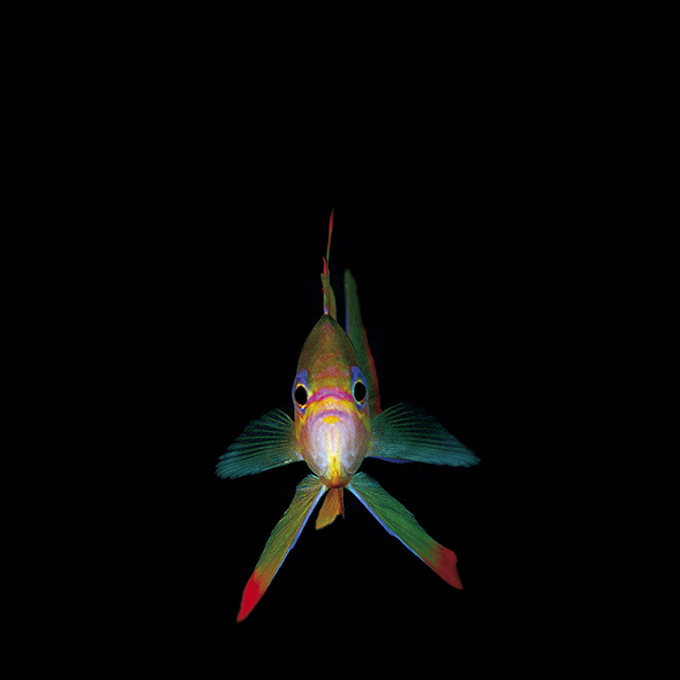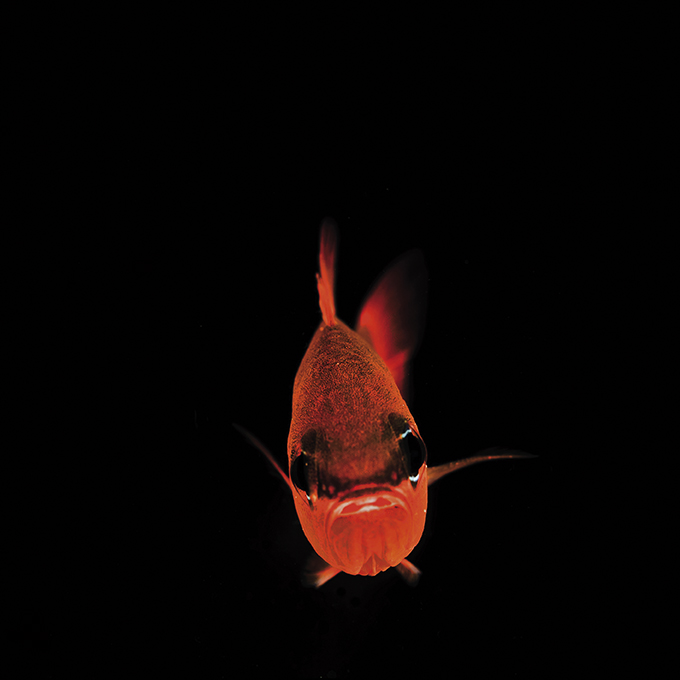
Title: Tropic of the Mediterranean
ISBN 978-88-92710-870
Author: Vincenzo Troisi - All rights reserved
COPYRIGHT © 2021, VINCENZO TROISI
The responsibility for all the contents of this work lies with the author.
All photos contained in this volume are the property of the author. All rights reserved.
All economic rights due to the author will be directly and entirely devolved to the association "12 scatti onblus" (12scatti.org)
First edition 2022
Edizioni ZEROTRE
tel. +39 045 71 141 34
www.edizioni03.com
davinci@artifices.it
On the cover The eye of a cuttlefish. The chromatophores, the sense organs that allow the animal to quickly change color and camouflage itself, are in frantic activity to try to distract the photographer, which, in this case, is detected as a predator.

Chromatic explosion on a power pylon that fell into the sea following a storm.

AUTHOR Enzo Troisi, from Salerno, has been diving with an aqualung for about forty years and became passionate about photography because of his need to bring “home” all the wonders encountered at sea. He soon realized that, in addition to technical issues, the important thing is not only to communicate shapes and colors, but emotions, understanding that photography comes from sensitivity, not only the technical ability of those who make the shots.
He participated in national and international competitions and photographic contests, and the remarkable results led him to be part of the “Club azzurro”, the national representative team of underwater photography.

A male pink damselfly (Anthias anthias) in “nuptial dress”, i.e., coloration during courtship.
TROPIC OF THE MEDITERRANEAN
It Was the 1969, I was 8 years old, and I had learned to swim.
I was shy, but if I wore fins, a gift by my aunt, which was an excellent swimmer, the familiar with sea considerably increased. The boost of fins gave me speed, and ensured me to safety.
I started to go out to open sea, and I rested near the boats moored in the harbor. I remember the fear, the terror I would say, when the waves struck under the keel. The noise it came back, and conspiratorial reading of “20,000 Leagues under the sea” had me persuaded that there was a huge octopus, attacked with its cups coming apart from the keel: in a few moments a long tentacle would have caught me to drag me into the abyss ... Inevitably I left as a rocket toward the shore, cartoon character style, which continues to swim even on the sand while escapes, and only when I touched the sand I was reassured to be safe.
I was ashamed to confess this cursed fear, and a good chance to wipe out it came from the discovery of the mask. With that instrument, in addition to discover, always in presence of my aunt of course, that no octopus was lurking, I started to discover the underwater world. A little time later, when for the first time I admired the dance of Posidonia beds (in my opinion they were the seaweed) I felt the emotion experienced by Commander Cousteau, I will mention later. Really they were the years of “the man and the sea” Italian TV show, and on wednesday night the appointment with the oceanographic divers of Calypso ship it was unmissable. Silver suits, single stage regulators, images from the Red Sea of pre-continent first, everything was marine science fiction, eyes glinted and heart palpitated.
It was ‘73, I was 12 years old, and regardless of the prohibition of my mother, my friend Giulio and I bought the underwater spear gun, a mythical arbalete, called “zip”. It cost us 2000 lira each – almost one dollar -, and we hid it, hooking it under a small wooden bench in the cabin of the beach.
I avoid dwelling on what happened when the hiding place was discovered by my mother: this is another story.
We dreamed about big catches, but the results were not exciting. It was spear gun’s fault, since it wasn’t very powerful. The time came of the “pantherino”, compressed air spear gun. Nothing to do, it wasn’t spear gun’s fault. My apnea was great, but those “ how beautiful!” which passed through my head just before pulling the trigger was the fleeting moment that the harpoon hits where the tail of the fish ends.
I still remember the crossings from the beach towards the inner arm of the port. We wondered which marvels we would have encountered if one day we had managed to overcome our columns of Hercules, the lighthouse: once dubbed it the outer arm waited for us, and it looked out on the open sea. Giant groupers, blue sharks, endless shoals of bream stirred up our nocturnal and diurnal dreams, while we reached at the stroke of oars our Polynesian atoll. I remember that we took an orange dinghy, masks, fins, breathing “tube” - the english “snorkel” was beyond coming - and we reached the sea landslide passing through the rows of mussels cultivated about 700 feet from the shoreline.
One morning, perhaps, was the moment when something changed, even if I didn’t understand it immediately. We were young, but not naive, and we put the safety rules into practice. When one dived, the other remained on the surface to control the situation until the companion’s ascent. Although we were in an harbour, at the time water was very clear. I dived with the rifle after a long, but not too much long hyperventilation, as the manual taught, and I started to compensate immediately after the firsts meters.
As I descended and descended, I thought of the competitions every afternoon I took with myself at home, sitting on my chair, when I held my breath as long as possible. The initial one minute and a half had almost doubled, but I knew that in the water it was something different: cold, movement, tension, drastically reduced the apnea.
I looked around and then up, towards the surface, both to try to guess how much it would have taken to me to go back, (I had seen the depth gauge just in magazines and shop windows). Really, admiring the sun from the deep blue was a fascinating spectacle. It was a moment, I saw the unmistakable shape of a big striped sea bream appearing from behind a rock. Immediately I tried to connect the brain to the notions acquired: den fish, if approached in free water it will try to take refuge. You have to cut off the road and be quick not allowing it to wedge in depth, hitting it when it turns around in its den, lending its side. It was easy to read, a little less to put into practice. I was starting, but immediately behind the first here was one another. It looked like they were twins, same size, same black stripe around the caudal fin, same movements. He repeated the same route, bypassing the rocky outcrop to go deep, where the blue becomes deep and deep.
And then here’s another, another, and one more. I went to get closer, but that damned principle of Archimedes sucked me up, while they, a dozen now, did not deign to me the slightest attention. I stood for a moment still watching them, I knew I had little air, and going up, for once, I did not look at the sun, but at that school.
And from there, from above, I observed the magic: they went down in row, following the same route as if they were remote-controlled. Today I would say that they were designed and programmed on the computer, so perfect were they, unreal in their majesty. It is a show I have never seen again or forgotten. “I wish I had a camera,” I thought... But it was another episode that marked the farewell to my inglorious underwater hunter career. Coming to shore from an hunting trip, obviously unsuccessful, removing the fins I attracted a bit of fishes which, in such cases, comes in search of food on the sand.
I noticed a striped seabream.
This time it was really little, and I had to unload the shotgun.
I instinctively fired, without aiming and without having the slightest pretense to center, it was a frustration shot more than a presumption one. Needless to say, the harpoon hit fully.
The animal was literally broken into two parts, and I remember, as if it were yesterday, its head, and its mouth panting, trying to keep breathing and living.
At that moment I decided that I would have left the rifle, and for a few years my relationship with the sea suffered a sharp slowdown.
The ‘78 came, and in Salerno, my town, some goodies decided to start a club, the G.O. Sub. They organized the first A.R.A. training course , the compressed air breathing apparatus. I was there, to become a “real” diver. Really I do not feel like it even today, almost 35 years experienced, but it was the chance my instinct wanted. Fascinated by the photos of underwater photo master Guido Picchetti, who at the “ underwater Christmas in Amalfi” projected images of tropical paradises, I bought the camera, the Nikonos IV with a 28 mm. lens with the first money I had earnt.
I was determined to capture all those “how beautiful “ II had missed some years before.
At the Giglio island, in 1984, I attended a photography course held by Guido. Later I was interested in the Mario Zucchi and Kurt Amsler style, which created underwater photo sets, and then I was hit by simple but fascinating shots: the strobe was not used to light up, but to give light to the subjects. They are two literally similar, but practically very different meanings. Underwater photographer was named Enrico Gargiulo, and his surname made me think of a gentleman who had to live not too far from me. It took me a while to find out that it was from Sorrento, a little more to find the courage to phone, a moment to drive to get the most precious lessons of my life. How many times I met Enrico and Rosaria, his technically genial wife, how many times I came back home, as they say, “with the tail between the legs”, persuaded to have shown a masterpiece, and hearing them saying, instead, that it was a so and so picture. At the beginning I could not even understand how an insignificant detail could be a “defect”, but they were right.
In 1984 I became graduate and I decided to make as gift to myself a trip to the Maldives. The feeling when I saw the coral reef can’t be described. However, I was left equally impressed, when a few weeks later I saw for the first time the “Ischitella” rock, in Praiano, on the Amalfi coast. I still see today the face of my friend Costantino, who shared with me the “discovery” of ad underwater wall overflowing with color. At the end of the dive, after a satisfaction smile he told me: “What have you been doing in the Indian Ocean for? Tropics are here! “. That impromptu joke has casually marked my life as an underwater photographer.
Because of fortuitous and familiar reasons, and of objective attraction, I dived more in the Mediterranean than elsewhere.
When I proposed something, editors of trade magazines asked me about Mediterranean press reports, because “we are full of tropical,” they confided. This represented a paradox and an incentive to me: Italy is for 2/3 surrounded by the sea, and historically it can boasts some of the best underwater photographers in the world. Yet it was, and so it is.
The Mediterranean environment is not easy to represent, water is often not clear, and, strange as it may seem, the spectacle of some places, rich in life and color, is often the result of the great quantity of nutrients, natural or unless they are, and they complicate the life of photographers. Besides the tiny life, critters, colored and unrecognized organisms are not as overflowing as in the tropics, where they are often stationery, and permanence of some
specimens in a very small micro-environment is frequent.
I remember the amazement when in the Red Sea the guide told me that he would have shown me a needle fish with a special color. During the dive, at a certain point he stopped, and without even looking, he slipped his hand behind a soft coral and by magic
appeared what he had promised. “It looks like a stuffed toy store,”
I thought.
Since then my interest in the Mediterranean increased little by little, I deepened my biology knowledges, and the visit of some places of great interest enriched my passion. As a photographer beyond the technique, while important I have always tried to impress an emotion on film or on the digital sensor.
I entered extemporaneous competitions, I was part of the “blue club”, the Italian representative of underwater photography, I collaborated with specialist periodical magazines in the field, when I am invited I hold exhibitions or I’m part of juries in competitions, and I moved from nikonos to the camera in housing, to digital, but I realized that the more I learn, the more I have to learn, and the desire to gather in a more or less organic way the photo material available was a natural incentive.
And so, I thought, if the Tropic of Cancer, the Tropic of Capricorn, are imaginary places, spatial conventions evoking exotic, white beaches, crystal seas full of life, why is not possible to create the “Tropic of the Mediterranean”? “But it does not exist” would be the objection, and then, let’s go and see if it’s so true ... I think that more than one untrained fellow looking at the photos of the book, would not think that he’s looking at Mediterranean shots
sometimes taken in the locality by the strong anthropization. Many species and situations depicted, in fact, can make you think of tropical paradises.
The fact is that there is much talk, in recent times, of “tropicalization” of the Mediterranean, let’s say that it is a fashionable topic among climatologists, biologists and, of course, divers. We fill our mouths and our names, we mix concepts. Above all, with the objective intrusion of species through the Lesseps channel from the Red Sea, and the Strait of Gibraltar from the Atlantic, we tend to confuse ideas, seeing tropics even where there are not .... just think that the actual famous barracuda schools, for example, do not come from “abroad”, but are typical of Mediterranean sea.
And then, there is so much clamor for the discoveries that occur continuously in the tropics, but can’t help but smile that some recently classified species, have their counterparts in the
Mediterranean, where they are more unknown than in the Pacific, or that episodes of symbiosis, commensalism, parasitism, or the life in common of some organisms are similar also in the Mediterranean. Muck dives, black dives, that are night dives in open sea, so in vogue in Pacific ocean can provide emoticons in Mediterranean too. In short, to paraphrase the famous saying that “the whole world is a country”, we can say that all the oceans ...
are sea.
The hope, of course, is that this book may surprise you. It would mean that its title goes beyond conventions, and that, at least in part, it has succeeded what should be, in my opinion, the aspiration of every photographer, that is to say on a flat support, which was the film, and now it is the sensor, the three-dimensionality of the world and of the life that surrounds us.
Have a nice one day dive…

A Mediterranean cardinal fish (Apogon imberbis).
AUTHOR'S NOTE The book is not divided into sections. The photographic sequence was deliberately conceived as a hypothetical, imaginary full-day dive in the Mediterranean Sea, such however as to go beyond the definition of "sports" diving. The sequence was also conceived by analysing the shapes and colours of the images. The challenge was to harmonise the presentation, similarly to a projection. With the exception of the images obtained from the combination of several photos at the layout stage, no alterations have been made to the portrayed scenes, nor additions or subtractions of the parts making up the original shots. The only changes concern the correction of colour levels, contrast and, where considered appropriate, re-framing of the original photographic angle.
The book comes from a great passion for biology and, as far as possible, from the careful observation of the sea and its creatures. These shots are the evidence of many years, some hundreds of dives and, as it always happens, a mixture of patience and luck. I’m persuaded that nature gives unrepeatable moments to those who wait. The photos, more than scientific observations, are emotions of an enthusiast guy frozen in a hundredth of a second. The captions are frequently long, and go from the story of the encounter to mythology and news from scientific community.
To offer innovative biological aspects, but a chance to comment on the knowledge of the most ancient sea in the history of. The center of trades, crossroads and witnessed bloody wars throughout thousands of years.
The Mediterranean is also known as the cradle of civilization and ancient archeology, but, paradoxically, it is a little bit snubbed its biological peculiarities. I hope that this book could be, albeit modest, food for thoughts…and for eyes.
Have a good dive...
Except for the declared the union of two different shots, nothing was manipulated of the original other than crop and correction of chromatic levels.
THANKS Although the Amalfi and Sorrento coasts are my favorite places, my “gyms” where I usually dive with friends of the Underwater Operating Group and the “Punta Campanella” diving center, according to the title of the book shots were taken in beautiful places all around Mediterranean Sea. They are reported in the captions.
Excusing me in advance with all those - certainly the most of - I forgot I can’t forget Paolo Barone of the “Scilla diving Center” for the support and friendship, Paolo Russo of the “Black sand” in Stromboli, Danilo, Giulio and Antonio of the “Mare Nostrum” diving of Ustica, Scipio and Ivan of “Progetto Atlantide” in Favignana, Stefano Baieri and Massimo
Giovannucci, former owners of “Dimensione Mare” on the Giglio island, the “Croatia divers in Korcula”.
More than thanks, a warm greeting goes to the friends I share this
“illness” for years. In strictly historical order, among the many that I will be forgetting, Guido Picchetti, who made shine in me the spark of photography, Constantine Volpe, in “presidential representation” of the “G.O. Sub”, Enrico, Rosaria, Arturo and Marco Gargiulo, Virgilio and
Giampiero Liguori, Massimo Sanfelice, I shared with many competitions, technical experiments and advises about his fantastic housing, Roberto Sabella, companion of many dives in that of Praiano, Antonio Bergamino, very precious for the graphic design, the photo editing and the infinite patience in the volume layout, Guido Villani, indispensable and precious scientific consultant, Pasquale Vassallo, for the affection, esteem and beautiful technical comparisons, “professor” Mimmo Roscigno, of incomparable skill.
A special greeting to Paolo Giliberti, my assistant and forced “model” during the underwater photography competitions at the Italian championships, who will be happy and will be returning, wherever he is.
USED GEAR Shots included in the book were taken with Nikon cameras Nikon F90, F100, d700 and d800e.
Used lenses are:
16mm Nikkor f2.8 fish-eye;
20mm Nikkor f2.8;
28/70 Nikkor f3.5-4.5 zoom;
60 and 105 mm Nikkor f2.8micro;
15 mm Sigma fish-eye f2.8.
Used housings are underwave, various electronic strobes.
The digital shots were taken in nef format, converted and stored in tif.


